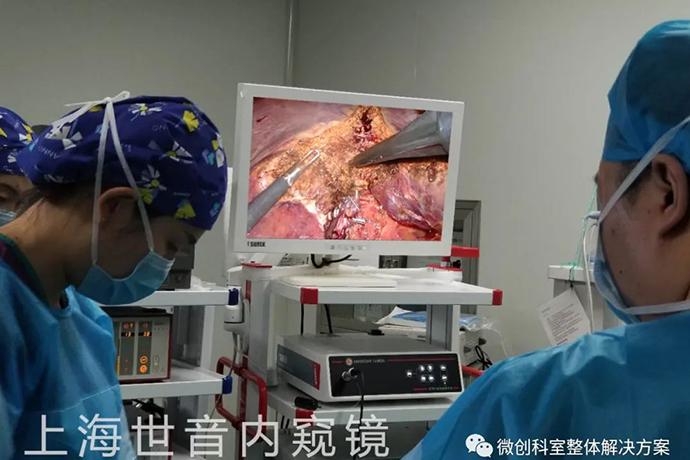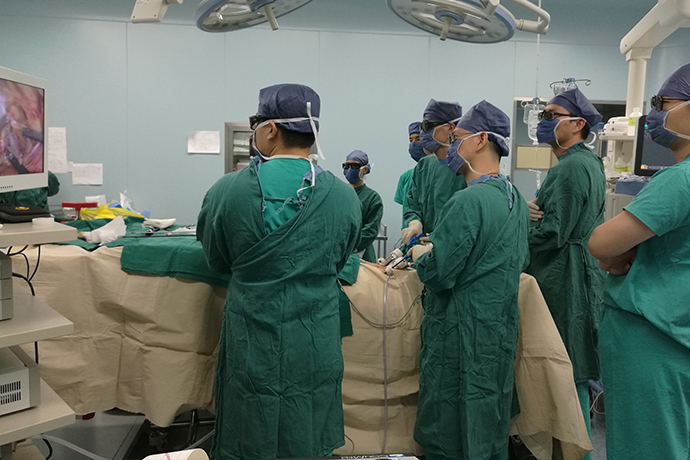[Laparoscopic Hepatobiliary Surgery] Resection of the right posterior part of the liver
Release time: 12 Jan 2023 Author:Shrek
Laparoscopic right hemihepatectomy is a technically difficult operation. The main reason is that the surgical procedure is complicated, the anatomical variation of the liver is more frequent, intraoperative bleeding is common, and uncontrollable bleeding is prone to occur, and the incidence of intraoperative and postoperative complications is high. This article briefly reviews the development of laparoscopic right hemihepatectomy at home and abroad, summarizes the operation process, and focuses on the details of the operation.

Reich et al. successfully performed the world's first laparoscopic liver resection in 1991, pioneering the clinical application of laparoscopic technology in liver surgery. In 1994, Zhou Weiping reported the first laparoscopic liver tumor resection in China. In 1997, Hüscher et al first reported laparoscopic right hemihepatectomy in the world.
In 2004, Nicbolas et al. from the Royal Brisbane Hospital in Australia reported 12 cases of laparoscopic right hemihepatectomy, 5 of which were successful, which was the first multi-case report in the world. Cai Xiujun was the first to report a successful complete laparoscopic right hemihepatectomy in China in January 2005. After 2005, the reports of laparoscopic right hemihepatectomy continued to increase, the operation time gradually shortened, and the rate of conversion to laparotomy also gradually decreased.
Although laparoscopic right hemihepatectomy is still one of the relatively complicated laparoscopic liver resections, with the advancement of laparoscopic hepatectomy technology, laparoscopic right hemihepatectomy is also increasingly used. The treatment of liver diseases has even become a routine standard operation in many large liver surgery centers at home and abroad.
In addition, in terms of liver transplantation from living donors, in 2006, Koffron et al took the lead in reporting the right hemidonor liver harvesting for living donor liver transplantation assisted by laparoscope in the world. In 2013, Soubrane et al. and Rotellar et al. respectively reported the right hemidonor liver resection under complete laparoscopy for living donor liver transplantation. At present, a few liver transplantation centers in China, such as PLA General Hospital and West China Hospital of Sichuan University, have carried out laparoscopic right hemidonor liver resection from living donors, but the number of patients is not many, and it is still in its infancy.
1. Surgical approach
There are two types of surgical approaches for laparoscopic right hemihepatectomy: conventional approach and anterior approach. At present, most liver surgery centers in China adopt the conventional approach, that is, to fully mobilize the surrounding ligaments of the liver, deal with the short hepatic vessels and even the right hepatic vein, and cut off the liver parenchyma under fully exposed conditions to avoid cutting the liver parenchyma to a deeper position. Bleeding was difficult to fully reveal and control, resulting in forced conversion to laparotomy.
The team of Professor Chen Yajin from Sun Yat-sen Memorial Hospital of Sun Yat-sen University routinely adopts an in situ anterior approach to cut the liver, cut the liver parenchyma from bottom to top, from shallow to deep, finely dissect the intrahepatic ducts along the "intrahepatic gap", ligate one by one, and finally deal with the perihepatic ligament . They believe that this operation method is more in line with the tumor-free principle in laparoscopic right hemihepatectomy for liver cancer. This standardized operation has played an active role in the popularization and application of laparoscopic right hepatectomy.
2. Surgical indications and contraindications
In terms of disease spectrum, the indications for laparoscopic right hemihepatectomy are basically the same as those for open surgery, including benign and malignant tumors involving the right hemihepatic, inflammatory lesions, right intrahepatic bile duct stones, and cystic bile duct confined to the right liver. Expansion, etc., and even right hemi-donor liver resection for living donor liver transplantation. However, at present, laparoscopic surgery cannot completely replace open surgery.
In 2013, the "Expert Consensus on Laparoscopic Hepatectomy" formulated by the Liver Surgery Group of the Surgery Branch of the Chinese Medical Association proposed that the indications for laparoscopic liver resection: benign diseases include symptomatic or spongy tumors with a maximum diameter of more than 10 cm. Hemangioma; symptomatic focal nodular hyperplasia or adenoma; symptomatic or hepatic cyst with a maximum diameter of more than 10 cm, intrahepatic bile duct stones, etc.
Liver malignancies include primary liver cancer, secondary liver cancer and other rare liver malignancies. In addition to contraindications for open right hepatectomy, contraindications include those who cannot tolerate pneumoperitoneum; intra-abdominal adhesions that are difficult to separate and expose lesions; lesions that are close to or directly invading large blood vessels; The second or third hepatic hilum affects exposure and separation; the hepatic hilum is violated or the lesion itself requires extensive hilar lymph node dissection.
In view of the high risk of laparoscopic right hemihepatectomy, Professor Cai Xiujun suggested that the anatomy of the first hepatic hilum and the treatment of the second and third hepatic hilum should be taken into consideration when selecting indications. Therefore, the indications for laparoscopic right hemihepatectomy The following conditions should be excluded on the basis of open right hepatectomy:
(1) Lesions near the hilum of the liver
(2) Hepatocellular carcinoma with obvious cirrhosis and abundant collateral circulation at the porta hepatis
(3) Recurrent cholangitis, resulting in right intrahepatic bile duct stones with obvious fibrosis in the hilar area. In recent years, with the continuous improvement of laparoscopic liver resection technology, the indications for laparoscopic liver resection have been expanding, and some of the contraindications that were considered in the past have become relative contraindications or even non-contraindications
The author believes that theoretically, the indications for laparoscopic right hepatectomy are close to those of open surgery, but we should be aware of the unbalanced development of laparoscopic hepatectomy. Due to the unevenness of the surgical technique of the surgeon, the indications and contraindications are not applicable to every operator of liver surgery. Individuals should choose their own surgical indications under the premise of fully ensuring the safety of patients.
3. Surgical method and steps
Patient position and poking card layout: The patient is placed in a supine position, the right retrohepatic area is elevated by 30°, the right arm is suspended, general anesthesia is used, and the five-hole method is used for operation. An incision was made 2 cm to the right of the navel, a pneumoperitoneum was established, a 10 mm poke card was inserted, and a 30° laparoscope was inserted, 2 cm below the xiphoid process, 5 cm above the umbilicus at the midline of the abdomen, and 6 cm below the costal margin of the right midclavian line A 12 mm disposable poke card was placed in the incision, and a 5 mm disposable poke card was placed in the incision 2 cm below the costal margin of the right anterior axillary line.
The double-surgery operation method is used. The operator on the right side of the patient holds the separating forceps or 100-gram forceps to separate the liver to facilitate exposure, and the right hand holds an ultrasonic scalpel or CUSA to separate the liver parenchyma. The operator on the left side of the patient holds an ultrasonic scalpel, bipolar coagulation or aspirator for operation.
Laparoscopic right posterior hepatectomy is one of the more difficult large-scale hepatectomy. It is necessary to be familiar with the anatomical structures such as the Rouviere groove, the retrohepatic inferior vena cava space, and the space next to the inferior vena cava, select the appropriate surgical position, surgical approach, liver transection plane, and hepatic blood flow control methods, and formulate a streamlined surgical approach. This series of strategies and measures can reduce the difficulty of surgery, shorten the learning curve, reduce the occurrence of conversion to laparotomy and intraoperative blood transfusion, achieve the homogeneity of laparoscopic right posterior resection, and ultimately benefit patients.
Diet precautions after surgery
As the saying goes, "Three points of treatment and seven points of nourishment", when a liver disease patient completes the operation and is discharged from the hospital, there are still many details that need to be paid attention to in daily life and eating habits. Here are some common sufficient items:
1. It is unscientific to take a lot of supplements. After liver surgery, some patients often eat too much nutritional supplements or some advanced supplements in order to recover their physical strength as soon as possible. In fact, this practice is very unscientific, because these substances are not easy to be absorbed and decomposed by the liver. The burden is not conducive to recovery, or should be based on daily diet. Xia Lei, Department of Liver Surgery, Renji Hospital Affiliated to Shanghai Jiaotong University School of Medicine
2. Stay away from alcohol and tobacco to keep you safe. It is very important to quit smoking and alcohol after liver surgery. The main component of alcohol is ethanol, which can be converted into acetaldehyde in the liver. They all have a direct damage to the liver, causing degeneration and necrosis of liver cells.
3. Self-cultivation improves resistance. After liver surgery, you need to pay attention to rest. The daily work and rest time should be fixed, ensure adequate sleep, and do not stay up late. It is necessary to carry out light exercise, such as walking, etc., but also pay attention to self-regulation, and cultivate the mind and nature. Don't be too tired. Overwork will consume nutrients and oxygen, resulting in reduced energy supply to the liver and weakening the liver's disease resistance.
4. Precautions for surgical incision. The advantage of laparoscopic minimally invasive liver surgery is that the incision is small and the postoperative recovery is fast. The suture removal time is usually 7 days after surgery. Some patients have been discharged from the hospital in less than 7 days after the operation. After returning home, the wound should be kept clean and dry. Generally, there is no need to change the dressing midway, and the stitches can be removed after returning to the ward 7 days after the operation. Of course, for the sake of convenience, Stitches can also be removed at a clinic near your home. The incision where the stitches have been removed is covered with gauze for about 3 days. When the time comes, remove the gauze and rinse with a shower. Itching is normal, but if there is obvious redness and swelling, you need to go to the hospital for treatment.
5. Postoperative follow-up is very important. Different patients have different requirements for postoperative follow-up visits due to their different conditions. For patients with liver cyst fenestration, cholecystectomy or hepatic hemangioma resection, the follow-up interval can be longer, usually once every three months; Patients with tumor resection need to be closely followed up after surgery, usually once a month in the first 6 months, and keep in touch with the doctor to arrange the next treatment plan.

- Recommended news
- 【General Surgery Laparoscopy】Cholecystectomy
- Surgery Steps of Hysteroscopy for Intrauterine Adhesion
- [Gynecological Hysteroscopy] Techniques for Preventing and Treating Complications of Hysteroscopic Surgery
- [Gynecological Hysteroscopy] Hysteroscopic Adhesiolysis
- [Gynecological Hysteroscopy] IUD Removal under Hysteroscopy